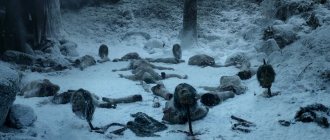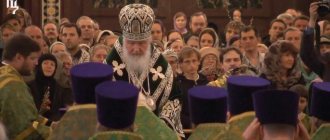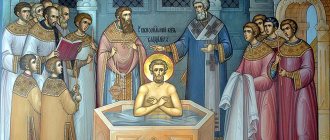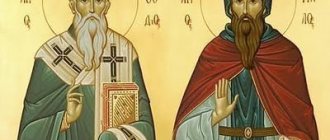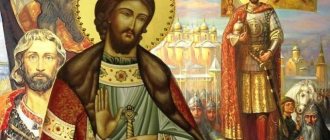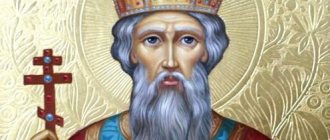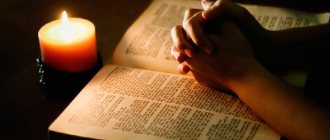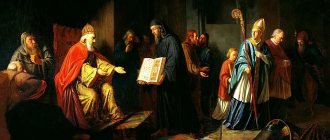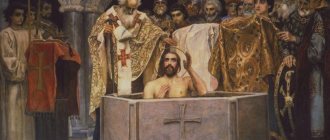The great and wise Prince Vladimir in 988 led Rus' to the Christian faith through the ritual of Baptism. Therefore, the image with his face is highly revered on the territory of the Russian state. On canvases, the Equal-to-the-Apostles prince is often depicted with a cross, similar to the one held by the first apostles. This attribute testifies to the rooting of Orthodoxy in the Fatherland, which has become the core of the Russian people.
Believers humbly ask the miraculous image for intercession, for reconciliation during quarrels or wars, as well as for deliverance from serious illnesses.
Description of the Holy Face
In almost every church in the Russian Federation one can see the Equal-to-the-Apostles Baptist of Rus', a wise sovereign who managed to ignite the fire of the Christian faith in the hearts of his fellow citizens. Vladimir determined the course of spiritual development of Russia as a great Orthodox power for many years to come. He forever cemented the memory of his deeds in the tablets of history. The icon depicting the great ruler inspires Christians to spiritual deeds, prayers and righteousness.
Holy Equal-to-the-Apostles Prince Vladimir
- The saint on the canvases is shown in full growth or half-length. He is dressed in traditional royal clothes (white dalmatic and red cloak), the head of the Equal-to-the-Apostles sovereign is decorated with a crown. The colors of the robe and the golden background create a harmonious impression for the observer. In the right hand of the wise ruler of Rus' there is a cross, referring to the judgment that the Orthodox faith is the foundation of the state. The left hand is pressed to the body, this indicates submission to the will of the Lord. In some other copies of the paintings, the saint holds a large sheet of Holy Scripture.
- Less often, the Baptist of Rus' is depicted standing next to Saint Olga, who is his grandmother. The princess became the first in the Fatherland to convert to Christianity, and her grandson followed in her footsteps. Vladimir and Olga are depicted in full growth, their clothes are red and blue, their heads are covered with traditional headdresses. In the right hands there are crosses reminiscent of the Suffering of Christ in the name of man. The prince's left hand holds a large sword, with the help of which he drove out enemies from the Fatherland.
Read about the saint:
- Relics of Saint Equal-to-the-Apostles Prince Vladimir
- Prayers to Saint Prince Vladimir
- Akathist to Saint Prince Vladimir
More to read:
- Episode 96. Battle of Borodino vs Bataille de la Moskova // April 29, 2012 // 9
- Episode 115. Bloody Sunday // June 22, 2011 // 9
- Episode 12. Battle of Kulikovo // May 15, 2011 // 6
- Episode 97. Moscow was given to the Frenchman, September 1812 // April 27, 2011 // 14
- Episode 43. Streltsy riot of 1698 // April 17, 2011 // 12
Tags: Vasnetsov, Prince Vladimir, Baptism of Rus', Eggink.
Help icons
The noble ruler bequeathed to the Russian people to see the true Creator and acquire the Orthodox faith. He asked the Lord for help against the enemy and always hoped for victory over the enemy forces.
- In front of the icon, the faithful are asked for intercession; the believer asks that God hear the request.
- The holy prince is able to protect Russian cities if a person is sincere in his prayers.
- He also rejects obsessions from dark forces, unclean magic and sorcery. The icon of the noble prince is capable of reconciling the warring parties, bringing peace and harmony to the relationship between the two conflicting parties.
- The saint saves from the influence of heretics who are trying to split Orthodoxy.
- Prayers to the miraculous image heal from serious illnesses and repel various intrigues of enemies.
Icon of Equal-to-the-Apostles Prince Vladimir
Ordinary lay people have the opportunity to say prayers not only in church, but also at home; for this it is necessary to build a personal iconostasis. In one of the corners of their own apartment, believers combine miraculous images with the faces of the Virgin Mary and Christ.
Advice! The Church also advises adding canvases with images of holy people after whom family members were named to the home iconostasis.
The Church annually remembers the Holy Baptist of the Fatherland on July 28 (NS).
Analysis of the petition
The prayer mentions that the faithful and God-chosen ruler of Rus' rejected paganism, accepted the One Trinitarian Lord and baptized Rus'. Believers praise the name of the enlightener Vladimir and thank him for his achievements, which allowed the Fatherland to enter the river of the Christian worldview. Through the Acceptance of Orthodoxy, the Russian people got rid of the blasphemy of God inherent in paganism, the torment of hell and the slavery of Satan, and also gained hope in the Kingdom of God.
The Equal-to-the-Apostles ruler became a leader on the path to the Creator, next to whom life becomes bliss. Vladimir is praised as a kind man of prayer and defender of Russian lands, patron of the national army and the common people. Ordinary phrases are not enough to express the greatness of the deeds of the Baptist of Rus'. The Christian asks the holy ruler for pardon and salvation, rejection from the path of dishonor and deception, deliverance from foreign invasion, internal schisms, as well as the grant of fertile lands, love and mutual understanding among fellow citizens.
The Orthodox people sincerely pray to the Lord and Baptist of Rus' for protection from internecine wars, attacks from outside, and from the weakening of faith. The Fatherland was defended by ancestors, among whom were kings and saints, they tried to preserve the territory and the established religion. The Holy Sovereign of Rus' eternally stands before God and begs for unity and peace for his descendants.
Important! It must be remembered that prosperity in the country will be achieved if every citizen wishes the best for those around him and does not forget about the basic principles of Christianity.
VLADIMIR RED SUN
The birth of Rus'. Academician B.A. Rybakov.
THE FLOWING OF KIEVAN RUSSIA VLADIMIR RED SUN
The fight against the Pechenegs became an urgent need for Russia in the 10th century. The entire fertile forest-steppe, densely covered with Russian villages and cities, was facing the steppes and was open to sudden raids of nomads who spread across the Russian plain for a “month of horse riding” from the Danube to the Zhiguli. Each Pecheneg raid led to the burning of villages, the destruction of fields, and the deportation of the population into slavery. Therefore, defense against the Pechenegs was not only a state matter, but also a national matter , understandable and close to all layers of society. And naturally, the prince who managed to lead this defense should have become a folk hero , whose actions were sung in folk epic tales - epics . Such a prince turned out to be Svyatoslav’s side son, Vladimir. In picturesque Lyubech , which guarded the approaches to the Kiev land from the north, a certain Malko Lyubechanin lived in the middle of the 10th century . His daughter Malusha was Princess Olga's housekeeper, and his son Dobrynya apparently served the prince . In the epics about Dobrynya, the memory is preserved that he was at the princely court “a groom and a gatekeeper ,” but then he became no longer a servant, but a courtier - “he worked and played for nine years.” Malusha Lyubechanka became one of Svyatoslav’s concubines, and her son Vladimir was born, who was later reproached for his origin, calling him “robichich”, “slave”. If not for special luck, the son of the housekeeper could have gotten lost in the crowd of “youths” and servants at the princely court. But his uncle Dobrynya once took advantage of the fact that the prince’s legitimate sons Yaropolk and Oleg refused to go to the distant northern trading post of Russia - Novgorod , and offered to send his nephew there. So the young Robichich Vladimir became the prince-governor in a small town on Lake Ilmen . After the tragic death of Svyatoslav, strife broke out between his brothers Yaropolk and Oleg , incited by the Varangian Sveneld, and Oleg Drevlyansky was killed. Dobrynya and Vladimir marched from Novgorod to Kiev, conquering Polotsk , an important trading point on the Western Dvina, along the way. Here Vladimir forcibly took Rogneda, the daughter of the Polotsk prince, as his wife . Russian epics reflect both Oleg’s struggle with Sveneld and Vladimir’s marriage through the mediation of Dobrynya. Yaropolk was killed in the palace by two Varangians from Vladimir’s army, and the son of the slave Malusha Lyubechanka became the Grand Duke of Kiev, and Dobrynya became the governor who administered the affairs of Russia.
The first state task of Prince Vladimir was the expulsion of the Varangian mercenaries from Kiev; he then established a pagan cult of six gods, led by the god of thunder and war, Perun . A series of successful military campaigns of Prince Vladimir against Poland, the Vyatichi, Lithuania, Radimichi, Bulgarians and Croats (in Transcarpathia) significantly expanded and strengthened Russia as a state of all Eastern Slavs . The rather amorphous early feudal state of Kievan Rus, the government of Vladimir sought to embrace a new administrative system, built, however, on the fusion of the state principle with the personal, typical for that era: in the place of the former “bright princes” who stood at the head of the tribal unions, Vladimir planted his sons: Novgorod - Yaroslav; Polotsk - Izyaslav; Turov - Svyatopolk; Rostov - Boris; Murom - Gleb; Drevlyansky land - Svyatoslav; Volyn - Vsevolod; Tmutarakan - Mstislav.
“Straight roads” are laid from Kiev to these distant cities, which are reflected in epics connecting them with the name of Ilya Muromets. the main task of Russia’s foreign policy still remained unresolved who were advancing on Russian lands along the entire forest-steppe border. The chronicle puts the following words into the mouth of Prince Vladimir:
“And Volodimer said: “This is not good, a small town near Kiev.” And they began to build cities along the Desna and along the Vstri (Ostra River) and along Trubeshevi and along the Sula and Stugna. And the husband began to narubati (“collect”) the best from the Slovenians and from Krivichi and from Chudi and from Vyatichi and from these the cities were inhabited. Do not fight from the Pechenegs and do not fight with them and give to them .
These words of the chronicle contain an extremely interesting message about the organization of national defense . Vladimir managed to make the fight against the Pechenegs a matter for all of Russia , almost all the peoples that were part of it, because military garrisons for the southern fortresses were recruited in distant Novgorod, in Estonia (Chud), in Smolensk and in the Moscow River basin , in lands where no one the Pecheneg did not jump. Vladimir’s merit was that he forced the entire forest north to serve the interests of the defense of the southern border, which ran through the lands of glades, streets and northerners. Of the five rivers on which new fortresses , four flowed into the Dnieper from the left. On the Left Bank of the Dnieper , fortresses were needed because there were fewer natural forest barriers and the steppe reached almost to Chernigov.
Now, after the creation of defensive lines , the Pechenegs had to overcome four barriers. The first was the line on the Sula River, a tributary of the Dnieper, which for 200 years served as the border between Russians and nomads. In “The Tale of Igor’s Campaign,” Sula , flowing with “silver streams,” and the Polovtsian land is allegorically depicted as follows: “the Komoni neigh for Sula.” At the mouth of the Sula, archaeologists excavated a fortress-harbour, where Dnieper ships could enter in times of danger: the fortified harbor had a characteristic name - Voin. Further along the Sula, the fortresses stood at a distance of 15-20 kilometers from each other. If the Pechenegs overcame this line, they encountered a new barrier along Trubezh, where there was one of the largest cities of Kievan Rus - Pereyaslavl. If the Pechenegs managed to take or bypass this obstacle, then the path to Chernigov and Kiev opened before them. But in front of Chernigov lay defensive lines along the Ostro and Desna, which made it difficult to approach this ancient rich city. In order to get from the left bank of the Dnieper to Kiev, the Pechenegs had to ford the river near Vitichev and then force the valley of the Stugna River. But it was along the banks of the Stugna that Vladimir set up his fortresses.
Archaeological excavations in Vitichev discovered a powerful fortress of the late 10th century on a high mountain above the ford with oak walls and a signal tower on the top of the mountain. At the first danger, a huge signal fire was lit on the tower, and since Kiev was visible to the naked eye from there, the capital immediately learned from the flame of the fire about the appearance of the Pechenegs on the Vitichevsky Ford .
The Stugninskaya defense line bordered the “Bor Velik”, which surrounded Kiev from the south . This was the last defensive line, consisting of the cities of Trepol, Tumash and Vasilyev and the ramparts connecting them. In its depths, between Stugna and Kiev, Vladimir built in 991 a huge city-camp , which became the reserve of all Kiev forces, Belgorod. The construction of several defensive lines with a well-thought-out system of fortresses, ramparts, and signal towers made a sudden invasion of the Pechenegs impossible and helped Russia go on the offensive. Thousands of Russian villages and cities were spared the horrors of the Pecheneg raids.
about this border line , the Western bishop Bruno wrote in the 9th century, traveling from the border outpost fortresses of Kiev to Pechenegia, about carved images of a winged anthropomorphic creature - a pagan amulet called the “chicken god” . People composed epic songs about the defensive outpost fortresses of Kyiv:
On the mountains, on the mountains, and on the high ones, On the Sholomya [hill] on the undulating, There stood a thin white tent. In the tent, the remote people are good fellows... They guarded and looked after the beautiful Kiev-grad .
Prince Vladimir was in great need of large military forces and willingly took into his squad people from the people who were famous for their heroic deeds. He also invited outcasts, people who involuntarily left their tribal communities and did not always know how to start an independent household; By doing this, the prince contributed to the further disintegration of tribal relations in the village. Outcasting ceased to be a terrible punishment - an outcast could find a place in the princely squad.
Victories over the Pechenegs were celebrated publicly and magnificently . The prince with the boyars and retinue feasted on the “entrance” (on the high gallery of the palace), and tables were set up in the courtyard for the people. These feasts were attended by “mayors and elders throughout the city and many people,” “countless multitudes of people.” The famous feasts of Vladimir, which were a unique method of involvement in the squad, are also sung in epics in full agreement with the chronicles:
In the capital city of Kleve, the affectionate prince Vladimir had a feast of honors for many, for princes for boyars, for the mighty for heroes, for all merchants for merchants, for all peasants of the village.
The people created whole cycles of epics about Prince Vladimir the Red Sun, about Dobrynya, about Ilya Muromets, about the fight against the Nightingale the Robber, the personification of tribal princes, about campaigns in distant lands, about the fight against cruel pagan customs and about the strong outposts of heroes guarding Kievan Rus from “filthy silushka.” As an oral textbook of native history, the people carried the solemn and majestic melodies of epics through a thousand years of their difficult life, supplementing the epics with new heroes, new events and turning to them in difficult years of disasters.
The heroic era of Vladimir (980-1015) was glorified by both the feudal chronicler and the people because in its main events it merged the feudal principle with the popular one, the prince’s policy objectively coincided with the interests of the people. Clerical historians sharply contrast Christianity with paganism and usually divide the history of each nation into two periods, considering the adoption of Christianity as the boundary; They call pre-Christian times in pagan ignorance, but Christianity supposedly shed light on their lives.
For some peoples who entered the path of historical development relatively late, the adoption of Christianity at that time meant joining the centuries-old and high culture of Byzantium or Rome, and thereby the thesis of the churchmen about darkness and light seemed to receive confirmation. But we, of course, must clearly separate the culture that developed back in the “pagan” period from religious ideology. Byzantium was not superior to the ancient Slavs because it was a Christian country, but because it was the heir of ancient Greece, preserving a significant part of its cultural wealth .
Christianity cannot be opposed to paganism , since these are only two forms, two different in appearance manifestations of the same primitive ideology. Both paganism and Christianity equally based on belief in supernatural forces that control the world . The strength and vitality of Christianity lies in the use of the ancient pagan concept of the afterlife , the “second life” after death. Combined with a very ancient dualistic view of the world as an arena for the struggle between the spirits of good and the spirits of evil, the thought of the afterlife gave rise to the doctrine of the same dualism in the “other life”, the existence of “heaven” for the good and “hell” for the evil . Christianity made extensive use of primitive magic in its practice , and the Christian prayer for rain, when a priest sprinkles the fields with “holy” water, is no different from the actions of a primitive priest who tried in the same magical way to beg the heavens to sprinkle the fields with real rain.
Being an eclectic (from ancient Greek ἐκλεκτός - “chooser”) and spontaneous unification of a number of ancient agricultural and pastoral cults , Christianity in its essence came very close to the pagan beliefs of the Slavs, Germans, Celts, Finns and other peoples. It is not for nothing that local folk pagan beliefs merged so closely with the alien teachings of Christians. The main difference between Christianity was that it passed its historical path in conditions of a sharply antagonistic class slave-owning society, and then in a difficult situation of crisis and transition to feudalism. Naturally, the primitive essence of those pagan cults from which the original Christianity was formed was complicated and modified: the religion of the social lower classes, which promised slaves consolation in the future afterlife , was used by slave owners, who introduced completely different ideological motives into it.
The feudal state further developed the class essence of Christianity. The Byzantine emperor was seen as the representative of God himself on earth. The magnificent and majestic ceremony of worship was aimed at consecrating the existing class orders. “Holy” emperors, patriarchs , and representatives of the nobility were depicted on the walls of churches The church space was usually divided into two tiers - ordinary people crowded at the bottom, and the lords and the highest nobility were located Christianity differed from paganism not in its religious essence, but only in the class ideology that over a thousand years was layered on primitive beliefs, rooted in the same primitiveness as the beliefs of the ancient Slavs or their neighbors. Christian missionaries who went to the Slavs or Germans did not bring with them anything fundamentally new; they only carried new names for the old gods , slightly different rituals and a much more refined idea of the divine origin of power and the need for obedience to its representatives. The worldview of the missionaries did not differ from the worldview of pagan priests, sorcerers and healers .
On a ship sailing on the blue waves of the Aegean Sea, some Russian scribe of the 12th century decided to write a study about Slavic paganism : “The word about how pagan peoples worshiped idols and made sacrifices to them.” Our traveler was familiar with the ancient Egyptian cult of Osiris, and the teachings of Mohammed in the Arab lands, and the customs of the Seljuk Turks, and the organ music in the Catholic churches of the Crusaders, which was unusual for the Russian ear. His ship sailed from south to north, through Athos and Constantinople , and on its way, which began, perhaps, somewhere in Palestine or even in Egypt, this scribe should have seen the island of Crete , famous in ancient times for the cult of Zeus-Dius , and the ancient temples of Aphrodite, Artemis, Athena , and the site of the famous Delphic tripod , which served for the predictions of the oracle (“ tripod of the Delphic sorcerer ”). Perhaps the abundance of ruins of ancient pagan sanctuaries encountered during the voyage inspired the unknown author to such a topic as comparing Slavic paganism with other ancient religions. Of exceptional interest to us is the periodization of the history of Slavic beliefs , which was proposed by this intelligent and educated writer.
1. Initially, the Slavs “laid prayers (that is, made sacrifices - B.R.) to ghouls and beregins.” 2. Then they “began to serve the meal (also make a sacrifice - B.R.) for the family and women in labor . 3. Subsequently, the Slavs began to pray mainly to Perun (while maintaining faith in other gods).
“Ghouls” are vampires, fantastic creatures, werewolves, personifying evil. “Beregyns” (associated with the word “ to protect”, “to protect”) are kind spirits that help a person. The spiritualization of all nature and its division into good and evil principles are very ancient ideas that arose among Stone Age hunters. Various conspiracies were used against ghouls , and amulets were worn ; In folk art, many extremely ancient symbols of goodness and fertility , depicting which on clothes, dishes, and homes, ancient people thought that signs of goodness, “amulets,” drove away the spirits of evil. Such symbols include images of the sun, fire, water, plant, flower .
The cult of Rod and women in labor, fertility deities, is undoubtedly associated with agriculture and truly reflects a later stage of human development - the Neolithic, Chalcolithic and subsequent times. Later, after the baptism of Russia, women in labor were equated with the Christian Mother of God. Rod was the supreme deity of heaven and earth, who controlled all the vital elements - the sun, rain, thunderstorms, water. Belief in one supreme God was the basis of later Christian monotheism.
The cult of Perun, the god of thunder, war and weapons, arose relatively late in connection with the development of the druzhina, military element of society. As you can see, the stages of development of primitive religion are indicated by the navigator writer very correctly and accurately. He also correctly described the last stage as dual faith - the Slavs accepted Christianity, “but even in Ukraine they pray to him, the cursed god Perun” and other gods.
calendar from Lepesovka in Volyn
The prayers of the pagan Slavs to their gods were strictly scheduled according to the seasons and the most important agricultural periods . The year was determined by solar phases , since the sun played a huge role in the worldview and beliefs of ancient farmers. The year began, as we do now, on January 1st. New Year's celebrations - Christmastide - lasted 12 days , capturing the end of the old year and the beginning of the new. On these days, they first extinguished all the fires in the hearths, then produced a “living” fire by friction, baked special breads and, using various signs, tried to guess what the coming year would be like.
The pagans always sought to actively influence their gods with the help of requests, prayers and sacrifices feasts were held in honor of the gods , at which bulls, goats, and rams were slaughtered, beer was brewed by the whole tribe, and pies were baked. The gods were, as it were, invited to these brotherly feasts and became people’s companions. There were special sanctuaries - “treasures” intended for such ritual feasts .
The Christian Church used pagan New Year's holidays, coinciding with them the Christian holidays of Christmas and Epiphany (December 25 and January 6) . The next holiday was Maslenitsa, a riotous and riotous celebration of the spring equinox, the meeting of the sun and the spell of nature on the eve of spring plowing. The Church fought against this holiday, but could not defeat it and only achieved its expulsion during the calendar period of Lent before Easter . At the time of plowing, sowing spring crops and grain “vegetating” in the ground, the thought of the ancient Slav turned to his “grandfathers” ancestors , who also lay in the ground. On these days, they went to the cemetery and brought wheat kutya, eggs and honey to the “grandfathers,” believing that their patron ancestors would help the wheat shoots . In ancient times, cemeteries were like “villages of the dead.” A wooden “house” (“pillar” ) was built over the burnt ashes of each deceased to these miniature houses and brought food to the ancestors in the spring and autumn. earthen mounds began to be built over the graves The custom of “bringing” on “parents’ days” persisted until the 19th century.
Throughout the spring and summer, the ancient farmer’s concern about the harvest increased: he needed rain on time, sunshine on time. The first spring holiday fell on May 1-2 , when the first spring shoots appeared. The second holiday, which later merged with the Christian Trinity Day, is the day of the god Yarila, the god of the spring sun and the life-giving forces of nature; On this day ( June 4 ), young birch trees were collected with ribbons and decorated with green branches at home.
The third holiday celebrated the summer solstice on June 24 - Kupala Day (Ivan Kupala). In all these holidays there is a persistent prayer for rain. Round dances of girls, ritual songs and dances in sacred groves, sacrifices to rivers and springs - everything was aimed at receiving the gift of heaven, rain . Kupala Day was preceded by “Russian Week” .
Mermaids are nymphs of water and fields , on whom, according to the Slavs, the irrigation of the earth with rain depended. It is well known in Slavic ethnography that on the days of such mermaid festivals , the most beautiful girls were chosen in the villages, wrapped around them with green branches and doused with water for magical purposes , as if imitating the rain that they wanted to cause by such actions.
The Kupala holiday was the most solemn of the spring-summer cycle . Worshiping the Queen of Water , the girls threw wreaths into the river and fire; on Kupala night huge bonfires were lit on the high hills, on the mountains, and boys and girls jumped over the fire in pairs . The cheerful playful part of these prayers remained for a very long time, turning from a ritual into a fun game for young people. Ethnographers of the early 19th century describe the magnificent spectacle of the Kupala bonfires in Western Ukraine, Poland and Slovakia, when from the high peaks of the Tatras or Carpathians hundreds of miles around one could see many fires lit on the mountains.
The climax of the Slavic agricultural year was the stormy, hot July days before the harvest . The farmer, powerless in the face of the elements, looked at the sky with fear: the harvest, grown by his hands, begged , as he thought, from the gods, was almost ready, but the menacing and capricious stormy sky could destroy it. Excessive heat could dry out the ears, heavy rain could knock down ripened grain, lightning could burn a dry field, and hail could completely devastate the fields. God, who controls the sky, thunderstorms and clouds , was especially terrible in these days; his disfavor could doom entire tribes to starvation.
Rod-Perun's Day (Ilya's Day - July 20) was the darkest and most tragic day in the entire annual cycle of Slavic prayers. On this day, they did not conduct merry round dances, did not sing songs, but made bloody sacrifices to the formidable and demanding deity, the direct predecessor of the equally cruel Christian god.
Experts in rituals and the exact calendar dates of prayers were the priests-magi and sorceresses-healers , who appeared in the primitive era. Along with pagan prayers for the harvest, which formed the content of the annual cycle of holidays , Slavic paganism included primitive animism - belief in goblins, water spirits, swamp spirits, and the cult of ancestors - veneration of the dead, belief in brownies.
Weddings and funerals were decorated with complex rituals. Wedding ceremonies were full of magical actions aimed at the safety of the bride , who was passing from under the protection of her household spirits to someone else's clan, for the well-being of the new family and for the fertility of the young couple .
The funeral rites of the Slavs became much more complicated towards the end of the pagan period due to the development of the druzhina element. Along with the noble Russians, they burned their weapons, armor, and horses. According to the testimony of Arab travelers who observed Russian funerals, a ritual murder of his wife . All these stories are fully confirmed by archaeological excavations of mounds. As an example, we can cite a huge mound as high as a four-story building - the “Black Tomb” in Chernigov, where during the excavations many different things were found from the 10th century : gold Byzantine coins, weapons, women’s jewelry and turkish horns, bound in silver, with chased patterns and a depiction of an epic plot - the death of Koshchei the Immortal in the Chernigov forests. The “Black Grave” , in which, according to legend, the Chernigov prince , is located on the high bank of the Desna River, and the fire of the grandiose funeral pyre should have been visible for tens of kilometers around.
Having reigned in Kiev, Vladimir I carried out a kind of pagan reform . In an effort, apparently, to raise ancient pagan folk beliefs to the level of state religion , next to his towers, on a hill, the prince ordered wooden idols of six gods: Perun with a silver head and golden mustache, Khors, Dazhbog, Stribog, Simargl and Mokosha. As if Vladimir even established human sacrifices to these gods, which was supposed to give their cult a tragic, but at the same time very solemn character.
“And the Russian land and that hill were defiled with blood,” says the chronicle. The cult of Perun, the main god of the warrior nobility , was introduced by Dobrynya on the northern outskirts of Russia, in Novgorod . Eight unquenchable fires burned there around the idol of Perun and the memory of this eternal fire was preserved by the local population until the 17th century. Stribog, who commanded the winds, was, in all likelihood, the god of the sky; Dazhbog - the god of light, heat, fertility (like the ancient Apollo): Khors - the god of the sun as a source of light. Semargl is a deity close to mermaids, the givers of moisture to the fields; this is the god of the soil, plant roots, a type of fertility deity. Mokosh (or Makosh ) was the only female deity in this pantheon and, obviously, personified the feminine principle of nature and the female part of the economy (sheep shearing, spinning). The attempt to transform paganism into a state religion with the cult of Perun at its head, apparently, did not satisfy Vladimir, although the people of Kiev willingly supported even the most extreme manifestations of the bloody cult of the warlike god.
In Kyiv, Christianity and its basic dogmas, so adapted to the needs of the feudal state, had long been well known. The first information about Christianity among the Rus dates back to the 860s - 870s. In the 10th century in Kiev there was already a church of St. Elijah , the Christian counterpart of Perun . By the time of Svyatoslav and Vladimir, there was significant Christian literature in neighboring Bulgaria, written in the Old Church Slavonic language, which was completely understandable to all Russians. But the Kiev princes were slow to accept Christianity, since, given the theological and legal views of the Byzantines , accepting baptism from their hands meant the transition of the newly converted people into vassal dependence on Byzantium.
Vladimir I invaded the Byzantine possessions in Crimea, took Chersonesus and from here dictated his terms to the emperors. He wanted to become related to the imperial house, marry the princess and convert to Christianity. There could be no talk of any vassalage in such conditions. Around 988, Vladimir himself was baptized, he baptized his boyars and, under pain of punishment, forced the people of Kiev and all Russians in general to be baptized. In Novgorod, Dobrynya , who had established the cult of Perun there, now baptized the Novgorodians . Formally, Russia became Christian. The funeral pyres on which the murdered slaves burned went out, the fires of Perun, who demanded victims like the ancient Minotaur, went out, but for a long time pagan mounds were poured throughout the villages, “otai” ( secretly) they prayed to Perun and the Svarozhich fire, and they celebrated exuberant holidays of their native antiquity. Paganism merged with Christianity.
The Church in Russia was organized as follows: at its head was the Metropolitan of Kiev , appointed from Constantinople or by the Prince of Kiev himself, followed by the election of bishops by a council. In large cities there were bishops who were in charge of all church affairs of a large district - the diocese . With the separation of individual principalities, each prince sought to ensure that his capital had its own bishop. The metropolitan and bishops owned lands, villages and cities , and they had their own servants, slaves, outcasts and even their own regiments. gave “tithes”—a tenth share of their tributes and quitrents— for the maintenance . The Church had its own special court and special legislation, with the help of which it imperiously and unceremoniously intervened in family and intimate life, in the thoughts and norms of behavior of people. In cities in the 11th and 12th centuries there were many stone and wooden churches in which priests (priests) and their assistants, deacons, served. Services in the church were conducted daily three times a day (matins, mass and vespers); Churchmen sought to regulate the entire life of parishioners and constantly influence their “flock.” On holidays, Christian churches held especially solemn services , which were preceded by night prayers - all-night vigils. The pomp of worship was supposed to influence the minds of ordinary people. But for a long time the churchmen complained that their churches were empty:
“If some dancer, or musician, or comedian is invited to a game, to a pagan gathering , then everyone joyfully rushes there and spends the whole day there having fun. If they call us to Church , then we yawn, scratch ourselves, stretch sleepily and answer: “It’s rainy, cold” or make some other excuse... At the games there is neither a roof nor protection from the wind, but often it rains, the wind blows, it blows blizzard , but we treat it all cheerfully, captivated by the spectacle that is disastrous for our souls. And the church has a roof and pleasant air, but people don’t want to go .”
Princess Olga in the Church of St.
Sofia in Constantinople All means of art were used by the church to assert its views on life and social structure. The speakers convinced the audience that “rulers are ordained by God,” that a person must buy himself, by submission and humility in this life, eternal bliss after death. Artists depicted the Last Judgment , when, according to the fantastic predictions of the prophets, all those who died over several thousand years of the world’s existence will rise from their graves and God will begin the final judgment, assigning the righteous to heaven, and the sinners to hell, to endless torment. The artist’s brush painted ugly devils grabbing sinners and throwing them into the oven, piercing them with hooks, tearing their bodies with dirty claws... Slender singing and solemn theatrical liturgical action were supposed to show the other, righteous pole of the Christian world. Architects sought to elevate church buildings above huts and mansions so that it was the churches that created the architectural ensemble of the city. While creating its art, the church constantly attacked secular amusements and interests:
“Woe to those who wait for the evening with its music - harps, flutes, tambourines... to those who pretend that they do not know what harm harps, games, dancing and singing bring.”
The church preacher condemns those respectable townspeople who are outwardly decent, but are carried away by street performers, dancing and singing, and even take children to feasts :
“Ask these shameless elders, how did the prophets and apostles live? Or how many apostles and prophets were there? They don't know this and won't answer you. But if we talk about horses or birds, or anything else, then here they are philosophers, sages!
One of the strongest church organizations were monasteries, which generally played a very important role in the history of medieval states. In theory, a monastery is a voluntary brotherhood of people who have renounced family and ordinary life and who have devoted themselves entirely to serving God. In fact, the monasteries were large landowners-feudal lords, owned villages, conducted wholesale trade, lent money at usurious interest rates and were always in the thick of life, taking a direct part in the everyday “fuss of the world” and in major political events. Abbots of monasteries, along with bishops, acted as diplomats, judges, and mediators . In the monasteries there was a sharp inequality between the poor without a family, without a tribe and those who came from a boyar or merchant environment. The highest church authorities - bishops and metropolitans - could only be chosen from among the monks, who, unlike ordinary priests and deacons , were called the black clergy. Some central monasteries, like Kiev-Pechersk (founded in the middle of the 11th century ), became a kind of theological academy, where the sons of large nobles willingly entered, seeking to make a career. Such monasteries had good libraries; Here chronicles were kept, sermons were written, internal monastic events were recorded, and the “ascetics”, “hermits”, and “silent” monks were glorified.
The rich economic life of the monasteries and the presence of an aristocratic stratum in them, freed (as we know from later data) from menial work, forced the administration to take measures to create such a decorative curtain that would cover the class essence of the monastery and would distract the attention of townspeople and peasants. Such a veil was the “blessed”, “holy fools” - mentally abnormal, weak-minded or crippled people, whose shortcomings were shamelessly exposed to all visitors to the monastery. A story has been preserved about one such holy fool , Isaac, who lived in the Pechersk Monastery in the 1060s and 1070s . He was “relaxed in body and mind,” he was tormented by nightmarish visions, and he was dressed in untanned goatskin ; the monastery cooks mocked him for his dementia and forced him to catch crows. Isaac either gathered the Children and dressed them in monastic robes, then stood barefoot on the burning stove, then “walked around the world, making the same freak.” The story about this unfortunate man was entered into the chronicle, and the author-monk deliberately presents the reader with the image of “God’s chosen one.” By the beginning of the 13th century , we see manifestations of anti-church and anti-monastic sentiments. Smolensk priest Abraham , famous for his erudition and eloquence, addressed his sermon to a very wide circle of townspeople, among whom were “small”, “handicraft”, and slaves. His teaching was close to the teaching of the Western European Waldenses, who opposed the clergy. The bishop and abbots judged Abraham.
The Russian Church played a complex and multifaceted role in the history of Russia in the 11th - 13th centuries . There is no doubt the benefit of the church as an organization that helped strengthen the young Russian statehood in the era of the rapid progressive development of feudalism. Its role in the development of Russian culture , in introducing the cultural riches of Byzantium, in the spread of education and the creation of major literary and artistic treasures . But the Russian people paid a high price for this positive side of the church’s activity: the subtle poison of religious ideology penetrated (deeper than in pagan times) into all sections of people’s life, it dulled the class struggle, revived primitive views in a new form and consolidated them in the consciousness for many centuries. people ideas of the other world, the divine origin of authorities and providentialism, that is, the idea that all destinies of people are always controlled by the divine will. Russian people were not as religious as church historians try to portray, but religious ideology, in all the weapons of medieval art, was an obstacle to a free understanding of the world.
Next... YAROSLAV THE WISE AND YAROSLAVICHI
YAROSLAV THE WISE AND YAROSLAVICHI
STRENGTHENING THE POWER
